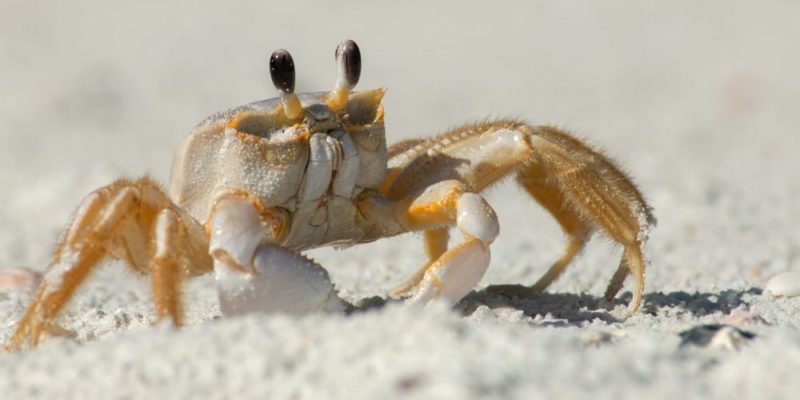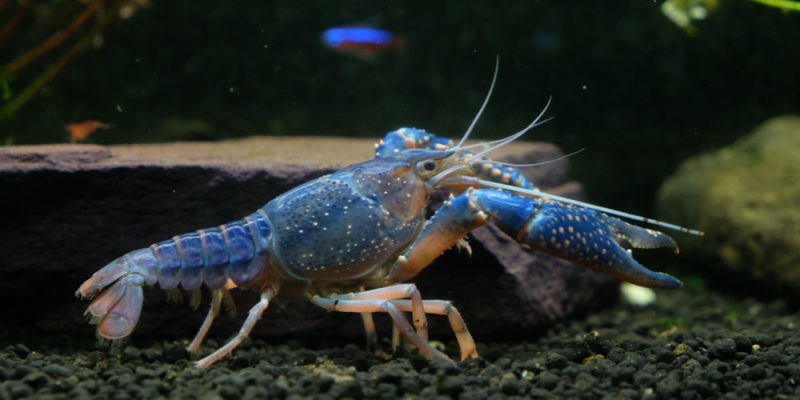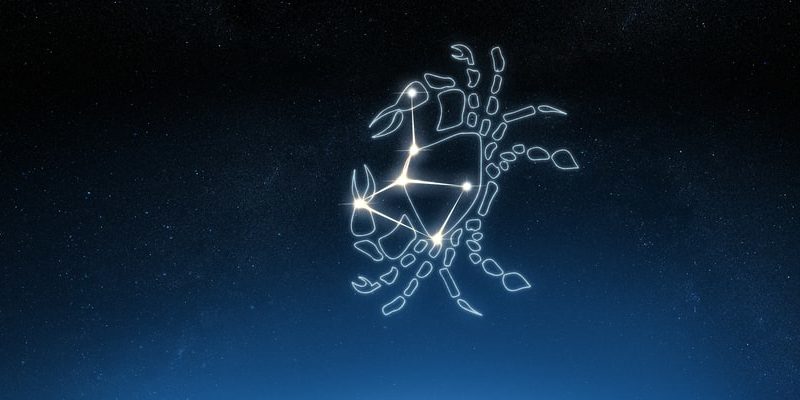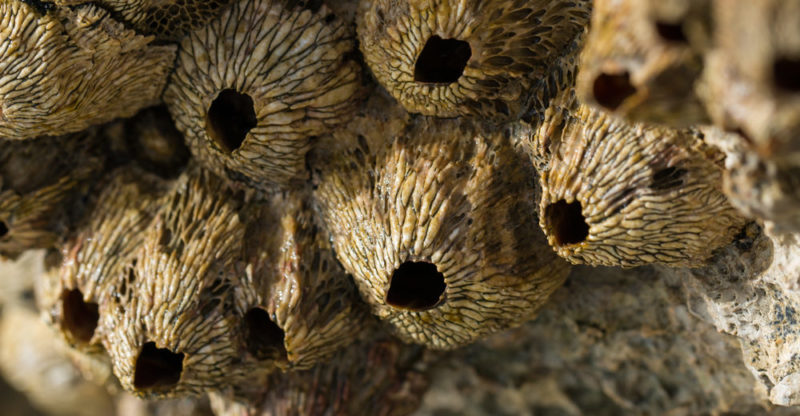We explain what crustaceans are, how they are classified and the habitat where they live. Also, what are its characteristics, examples and more.
What are crustaceans?
Crustaceans are a very extensive group of arthropod and invertebrate animals , mainly from aquatic habitats. They are endowed with an articulated exoskeleton composed of a carbonate called chitin. This is where its name comes from (from the Latin crusta , "scab" and aceum "relationship or nature").
In total, around 45,000 species of crustaceans are known worldwide. There is so much morphological diversity among them that it is impossible to include them all in the same and only definition.
Origin of crustaceans
 The first crustaceans in the fossil record appeared in the Cambrian or Cambrian period, in the Paleozoic era , about 540 million years ago .
The first crustaceans in the fossil record appeared in the Cambrian or Cambrian period, in the Paleozoic era , about 540 million years ago .This period was characterized by a true explosion of life and proliferation of species, among which the first marine arthropods appeared.
Like their terrestrial cousins, the evolutionary success of crustaceans has to do on the one hand with their resistant but agile body , articulate and capable of precise movements. On the other hand, it is due to your sensory system, which can range from just one to hundreds of different eyes.
Classification of crustaceans
 The classification of crustaceans has always been a difficult task for zoologists. Six distinct classes are usually recognized:
The classification of crustaceans has always been a difficult task for zoologists. Six distinct classes are usually recognized:
- Brachiopoda . Small to medium-sized species with appendages in the cephalic region in the form of a sheet. They live mostly in fresh water and some 900 registered species are known.
- Remipedia . Blind crustaceans fromdeep and salty waters , typical of the intertropical regions. They are usually transparent white, do not have eyes and are hermaphroditic.
- Cephalocarida . They are small and simple crustaceans, with a morphology very similar to that of primitive crustaceans. They have a long body, almost without eyes, with many appendages accumulated in the thorax, divisible into eight segments. They inhabit the benthic areas of the ocean (the bottom of the seas ).
- Maxilopoda . Very small arthropods (there are 0.1 mm) and reduced abdomen and appendages. There is an enormous diversity of known species.
- Ostracoda . Small and diverse crustaceans (some 13,000 known species) and abundant in the fossil record, have a pair of calcareous shells (made of calcium carbonate) around their body, within which they have a typically crustacean body, with 4 pairs of appendices.
- Malacostraca . The largest and most abundant group of crustaceans known, with more than 42,000 registered species, among which are the best known and edible. Mealybugs and terrestrial crustaceans are also included here.
Crustacean habitat
 The habitat of crustaceans is almost always aquatic , either underwater (salt water) or in rivers and lakes (fresh water). It is common to find them in coral reefs, buried in the sand or even at the bottom of the oceans (the abyssal zone).
The habitat of crustaceans is almost always aquatic , either underwater (salt water) or in rivers and lakes (fresh water). It is common to find them in coral reefs, buried in the sand or even at the bottom of the oceans (the abyssal zone).Among the smallest life forms in the sea are tiny crustaceans . Together with plankton, they make up the base of the entire food pyramid.
Only a few species of crustaceans have managed to conquer life on land , such as scale insects (isopods). Others, on the other hand, are amphibians , living on land but going to the water to spawn.
Crustacean feeding
Depending on the species of crustacean, feeding can range from predation, symbiosis, and scavenging. They tend to hunt small species of fish , mollusks, and smaller crustaceans , but they also take advantage of the hunting debris of large ocean predators .A significant case is that of certain types of shrimp or prawn that, in an unspoken pact with certain fish, admit to getting into their mouths and cleaning their teeth . Thus, they take over the decomposing organic matter and mutually benefit from this symbiotic relationship.
Reproduction of crustaceans
 Crustaceans have two separate sexes and reproduce by oviparous external fertilization : the female places the eggs in a bag or sac that adheres to rocks or to her own belly, and the male then fertilizes them, spraying them with his sperm.
Crustaceans have two separate sexes and reproduce by oviparous external fertilization : the female places the eggs in a bag or sac that adheres to rocks or to her own belly, and the male then fertilizes them, spraying them with his sperm.Freshly hatched crustaceans must molt several times throughout their development. Thus, they can grow into adult life and sexual maturity.
Crustacean anatomy
 The body of crustaceans is covered in a chitin shell that protects its soft and cuddly interior . In addition, it gives the necessary hardness to its appendages (such as tweezers or chelicerae). Your body is segmented and divided into several parts:
The body of crustaceans is covered in a chitin shell that protects its soft and cuddly interior . In addition, it gives the necessary hardness to its appendages (such as tweezers or chelicerae). Your body is segmented and divided into several parts:
- Cephalon or head. In it are the proto-brain and the sensory organs, usually two pairs of antennae, as well as the jaws and eyes, which can be a pair or several pairs, depending on the species.
- Thorax and pereion. In the thorax are the appendages of the crustacean, which can vary in number and function. There are usually four pairs of legs, and another pair with a secondary function, such as claws or appendages not dedicated to locomotion.
- Abdomen or pleon. The lower part of the crustacean, the softest and usually the least exposed, being the most vulnerable, are usually shovel-shaped to help the animal swim, or are very small (almost absent) and serve only excretory and reproductive functions .
The enormous diversity of forms of crustaceans must be taken into account , which allows exceptions to many of the morphological norms that we detail.
Crustacean respiration
Being mostly marine, most crustaceans breathe through gills , similar to other species adapted to life in water. Even those species whose life passes on land require water for spawning.
The growth of the young also takes place in water where, before beginning their adult life, they go through numerous larval phases during which there is gill respiration . In terrestrial species, it is later replaced by the pulmonary .
Crustaceans in culture

Many crustaceans are part of the diet of coastal human populations , especially crabs (of which there is a huge variety), shrimp, prawns and in particular lobster, whose white meat is regarded as an international delicacy. They are considered, along with mollusks, as aphrodisiac foods.
Some crustaceans such as the crab have attracted the attention of man , especially because of their particular walk (sideways or backwards); so much so that Greco-Roman cultures immortalized the crab among their zodiacal constellations (the sign of cancer ).
Importance of crustaceans
Crustaceans represent an enormous evolutionary success within the arthropoda phylum , and together with insects they share the world, being the most numerous and abundant living beings in the entire underwater world.
Arthropods constitute the food base of practically the entire marine ecosystem , as well as important detritophages (decomposers).
Examples of crustaceans

Some popular examples of crustaceans include crabs, hermit crabs, spider crabs, lobsters, prawns, and shrimp . Also the moisture mealybugs, which live on land; or barnacles and sea acorns, which live fixed to the rocks.
The above content published at Collaborative Research Group is for informational and educational purposes only and has been developed by referring reliable sources and recommendations from technology experts. We do not have any contact with official entities nor do we intend to replace the information that they emit.
Luke is passionate about fostering student involvement and connection. He studied psychology for his major and likes learning about the past. Luke aims to specialize in artificial intelligence and cybersecurity. .
Leave a reply
Your email address will not be published. Required fields are marked *Recent post

Sport: What Is It, Types, Risks, Features, Characteristics and Examples

Dogs: Emergence, Features, Characteristics, Feeding and Breeds

Story: Definition, Elements, Structure, Features and Characteristics

